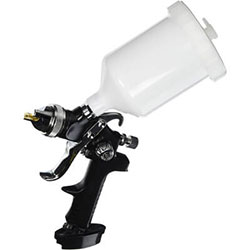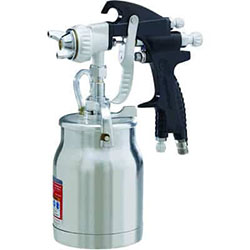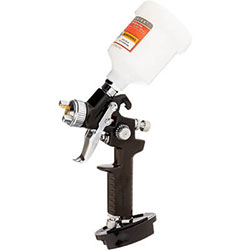The Best Spray Guns from Ingersoll Rand — Buyers Guide, Review, and Comparison
Backed with 150 years of tool manufacturing experience — the Ingersoll Rand spray gun range offers pneumatic units that are as reliable as they are robust. While the line-up may not be as extensive as some sole gun specialists, it includes machines for large, small, automotive, and touch-up projects. Including HVLP, suction, and gravity-fed sprayers — there’s a tool for the most demanding DIYers.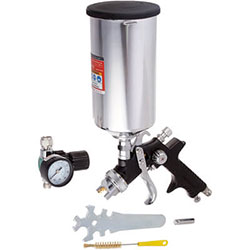
- Suited to medium-to-large projects.
- Metal paint cup.
- Choice of spray patterns.
Top Ingersoll Rand Paint Sprayers
| IMAGE | PRODUCT | DETAILS | ||
|---|---|---|---|---|
|
Best for Medium-Sized Projects 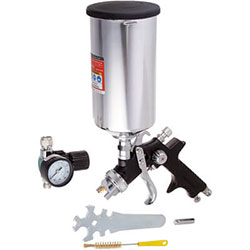
|
Best for Medium-Sized Projects
|
Ingersoll Rand 270G Edge
|
Features
|
Check Price at Amazon Ingersoll Rand 270G Review Ingersoll Rand 270G Review |
|
Best for Fine Finishing 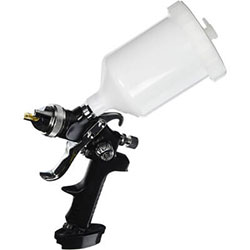
|
Best for Fine Finishing
|
Ingersoll Rand 210G Edge
|
Features
|
Check Price at Amazon Ingersoll Rand 210G Review Ingersoll Rand 210G Review |
|
Best for Large Projects 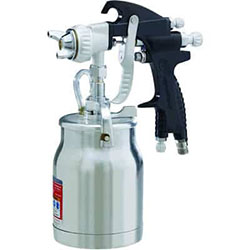
|
Best for Large Projects
|
Ingersoll Rand 210CSA Edge
|
Features
|
Check Price at Amazon Ingersoll Rand 210CSA Review Ingersoll Rand 210CSA Review |
|
Best for Touch-Ups 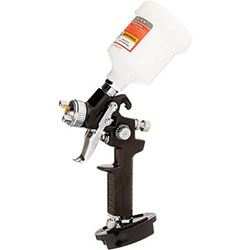
|
Best for Touch-Ups
|
Ingersoll Rand 200G Edge
|
Features
|
Check Price at Amazon Ingersoll Rand 200G Review Ingersoll Rand 200G Review |
Ingersoll Rand Spray Gun Buying Guide
With a company history dating back over 150 years — the Ingersoll Rand spray gun range is built upon decades of industrial equipment experience and innovation.
Although offering a relatively small line-up of products in the powered painting category, its machines are respected for their durability, blemish-free finishes, and suitability for both light-contractors and serious home enthusiasts — and having the backing of a manufacturing powerhouse.
The Ingersoll Rand Brand
In 1871, Simon Ingersoll, a farmer and part-time inventor, developed the world’s first steam-powered percussion rock drill — a tool designed to replace the traditional hand-operated version in construction and mining industries. Seeing the potential of this machine, Henry Sergeant, a quarrying specialist, purchased the patent and retailed it from his newly founded business, Ingersoll-Sergeant.
Weirdly, in exactly the same year, Addison Rand, another industrial innovator, incorporated the Rand Drill Company and created the Rand Slugger drill. A tool that, like Ingersoll’s creation, was designed to take away the manual effort from hole boring — but instead of being steam-driven, it was powered by compressed air.
Hence, there were two new companies, both with their own unique machines, competing for an identical customer base.
Michael Grace, an entrepreneur, saw an opportunity. He understood that these businesses were fighting for market share — and in the process, were losing money through extensive marketing and advertising.
In a solution that suited all parties, Grace purchased both the Rand Drill Company and Ingersoll Sargeant — and called the venture Ingersoll Rand.
Over the next century, Ingersoll Rand expanded its industrial operations. While still manufacturing powered tools, it began to retail products as diverse as petrol pumps, winches, and golf carts. However, always at the heart of the company remained its pneumatic line — including compressors, bolt guns, and of course, paint sprayers.
Today, Ingersoll Rand is considered to be one of the premier manufacturers of industrial-grade tools. It employs nearly 7000 people and reported a turnover of $14.2 billion in 2017.
The Ingersoll Rand Paint Sprayer Product Range
Ingersoll Rand’s sprayers fall under the Edge marque — a line of products that encompasses its full air tool range — featuring, in addition to coating guns, drills, hammers, saws, sanders, and ratchets.
But, don’t expect a catalog the size of the California phone directory — their painting line-up includes just four machines. This includes a:
- Gravity-feed touch-up gun.
- Suction feed general purpose unit.
- Gravity-feed fine finish machine.
- Gravity-feed HVLP gun.
While this may be more than adequate for the keen home user or light contractor — it could be too restrictive for the industry pro sprayer. Furthermore, with few upgradeable parts, these guns are tough to customize — which may deter the control-freak power painter.
So, if you’re looking for a massive catalog and the ability to tailor the gun for your particular applications — I suggest checking out the Eastwood and Tekna brands instead.
Why Choose an Ingersoll Rand Paint Sprayer?
The brand is renowned for durability and robustness, together with years of industrial manufacturing know-how.
Purchasing a spray gun from this company means possessing a machine that:
- Comes from a US-based company.
- Has the backing of an impressive warranty.
- Hails from an industrial equipment specialist.
- Is ideal for hardcore DIYers and light contractors.
- Promises unrivaled support from its customer service team.
- Delivers durability even through extensive use.
Ingersoll Rand Spray Guns — Our Top Picks
Ingersoll Rand 270G Edge
Best for Medium-Sized Projects
As the only Ingersoll Rand HVLP spray gun, this unit should appeal to DIYers attacking medium to large-scale projects — such as addressing fences, decking, and automotives — yet who still demand a pleasing and flaw-free finish.
A generous 1.03-quart paint cup should reduce the requirement for frequent refilling, saving you mess, hassle, and time. Boasting a robust metal construction, it will withstand the majority of knocks and bumps that are concomitant to hardcore use.
Being both HVLP and gravity-fed, the air volume requirement is low — knocking out 8 CFM. Thankfully this means that you don’t need the mother-of-all air compressors to drive the gun — which should please those using a standard consumer-style pneumatic power unit.
It’s 1.5 mm tip is designed to deliver finishing mediums such as lacquers, stains, and sealers — although, avoid filling the cup with viscous paints without significant thinning — unless you want a blocked machine. Providing high-material transfer efficiency, the Rand 270G reduces wastage and lowers the risk of overspray.
Focused tailorability is at the heart of this gun. It boasts an in-line air regulator and gauge — not only allowing you to adjust the pressure delivery to suit your medium, but also permitting you to monitor the power setting for precise control. Additionally, the Edge 270G also includes adjustment knobs to set spray pattern and coating material volume.
- Affordable HVLP machine.
- Large paint container.
- Complete with gauge and regulator.
- Low overspray.
- Ideal for medium-sized projects.
- Metal cup.
- Positive online Ingersoll Rand HVLP spray gun reviews.
- Incorporated ladder hook and filter.
- O-rings perish rapidly.
- Dials can be stiff.
- Cannot use latex paint.
- Design
- Functionality
- Price
Ingersoll Rand 210G Edge
Best for Fine Finishing
The unit incorporates a 0.63-quart (600 ml) gravity-feed cup — stated by the manufacturer to be drip-free — ensuring that your work (or home) doesn’t succumb to unwanted mess and helping to prevent medium wastage.
For flexibility, the 210G has two flow control dials, one for fluid volume and the other for air intensity. This permits you to adjust your delivery to suit both your painting medium and base material. Additionally, the versatile nozzle provides three spray pattern settings.
The gun houses a filter, crucial for detail work where a blemish-free finish is required. Furthermore, this vital component ensures that the internals are shielded from dirt and detritus — that could otherwise impinge the function of this precision tool.
The top of the unit features a ladder hook — permitting handy storage while in use — while the screw-lid acrylic cup offers easier cleaning than its metal-constructed counterparts.
- Excellent for finishing work.
- Easy-clean container.
- Internal filter.
- Non-drip design.
- Choice of spray patterns.
- Robust construction.
- Incompatible with viscous mediums.
- Lacks clear operating instructions.
- The trigger can be a little stiff to squeeze.
- Design
- Functionality
- Price
Ingersoll Rand 210CSA Edge
Best for Large Projects
Incorporating a generous 1.03-quart (975 ml) suction-feed container, refilling should be kept to a minimum, making the gun ideal for larger project work. That said, featuring a quick-release clip, downtime is reduced should the cup require replenishment.
Its 1.8 mm (0.07-inch) tip can cope with denser mediums, such as latex and chalk-based paints — suiting wall covering applications. Nethertheless, many users find that a little dilution of around five-to-eight percent provides the ultimate delivery of these thick liquids.
A full metal construction, including the cup, provides reassuring durability — crucial for substantial jobs. Furthermore, a simple twist of the gun nozzle permits you to switch between circular, horizontal, and vertical patterns — allowing you to coat your base material in the most efficient manner.
At 1.5 pounds, the 210CSA Edge is relatively lightweight for a heavy-duty machine — useful to stave off fatigue on longer jobs. Additionally, boasting extensive texturing on the handle, it shouldn’t demand too much finger-grip to hold the unit securely — even in gloved, perspiring, or paint-covered hands.
- Adjustable material flow control.
- Viscous medium compatible.
- Generous cup capacity.
- Tailorable air pressure delivery.
- Durable metal construction.
- Ribbed trigger.
- Quick-release container.
- At 12 CFM, requires a larger compressor.
- Cup liable to dripping.
- Dismantling the nozzle head can be challenging.
- Design
- Functionality
- Price
Ingersoll Rand 200G Edge
Best for Touch-Ups
The 200G Edge is perfectly suited to hobbyist modeling, furniture tidying-up, and small automotive applications — such as rejuvenating a fender or trim.
Furthermore, its gravity-feed acrylic cup is pleasingly compact. Having just a 0.13-quart (125 ml) capacity — you’re not wielding a container that’s ridiculously oversized for your project. Additionally, this bijou construction permits you to access more confined areas, where a larger cup would present issues.
The three spray pattern nozzle is compatible with most thin mediums, including stains, sealers, urethanes, and enamels — although due to its small diameter, dense coatings shouldn’t be used with this unit.
Retouches require precise control — you don’t want to drench a small car-wing paint-chip with a gallon of paint, nor cover the entire panel. Hence, it’s pleasing to see that this gun permits user-adjustment of both air and medium volume delivery.
- Suitable for small project touch-ups.
- Compact paint container.
- Fine nozzle.
- Includes a ladder hook.
- Textured handle for a precise grip.
- Acrylic container permits rapid cleaning.
- Non-drip cup.
- Clogs easily, even with some less dense mediums.
- Job-specific design limits the number of applications.
- A handheld turbine may be more suitable for retouching — no requirement for a compressor.
- Design
- Functionality
- Price
Conclusion
While offering a limited line-up of just four sprayers, Ingersoll Rand has provided the enthusiastic DIYer and light contractor with a tool for every project — fine finishing, medium-scale, touch-ups, and larger jobs.
And although all the units in this review are praiseworthy, for me, the impressive 270G Edge stands above the rest.
This HVLP machine is perhaps the most versatile of all the Ingersoll sprayers — able to address medium to large-scale work with its substantial 1.03-quart cup and 1.5 mm tip. Furthermore, an included in-line air pressure gauge offers precise control for exacting work, while its low-overspray design ensures a clean finish and less wastage.
Admittedly, its inability to deliver viscous paints may be disappointing for some guys — especially when comparable units such as the HVLP Central Pneumatic can cope with latex and chalk-based mediums.
That said, most DIYers will be able to find a reliable and durable gun in the line-up for their home projects — so I recommend checking out the Ingersoll Rand spray gun range.
Ingersoll Rand FAQs
Q: Are Ingersoll Rand Sprayers Any Good?
Its paint gun range includes units for the keen DIYer and light contractor. The products are robust and reliable, and incorporate HVLP, gravity-fed and suction-fed sprayers.
Q: Will the 270G Edge Spray Enamel Paints?
Yes. The Ingersoll Rand Edge 270G works well with enamels, lacquers, shellacs, and stains.
Q: Can I Spray Plasti-Dip With the 210G Edge?
No. The Plasti-Dip is too dense for the 1.4 mm tip of the Ingersoll Rand Edge 210G. If this is a requirement, I suggest checking out the DeVilbiss FinishLine 4 instead.
Q: Can I Use an Ingersoll Rand Sprayer to Paint My Car?
Yes. The 270G Edge is compatible with clear and topcoats for car respraying. However, if this is your niche of interest, I’d recommend taking a look at the Eastwood range of guns — specialists in automotive applications.
Q: How Large Is the Turbine in the Ingersoll Rand 200G Edge?
As a pneumatic gun, the Edge 200G is powered by a compressor, not a turbine. If you’re in pursuit of a turbine machine, check out my top picks here.
Q: Where Can I Find the Ingersoll Rand Spray Gun Manual?
You can obtain the user guides for all the Ingersoll Rand paint sprayers on the official company website — For rapid access to the Ingersoll Rand manual.
Q: Is There an Ingersoll Rand Airless Sprayer?
No. All the Ingersoll Rand paint guns are pneumatic — that is, powered by a compressor. If you’re looking for an airless machine, I recommend you check out my top products here.

